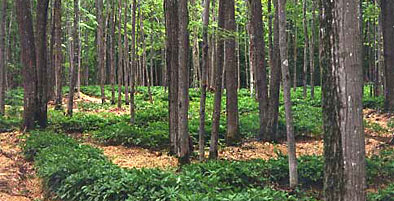Woodland medicinal, edible and decorative plants can be managed in prepared beds beneath the forest canopy. We take a look at some of the woods-grown plants at Enchanter’s Garden and see how a changing forest may dictate where new beds should be planted and old ones should be abandoned. Once invasive plants or insects enter the picture, various tree species may die off, leaving an open canopy and allowing for too much sunlight to reach the forest floor. A prepared bed will generally last for years. To prepare a bed for seeds or starts, rocks, leaves and other detritus should be raked away. Any plants of value can be removed to be replanted later. Amendments such as bone meal, leaf compost, soil and plant-tone can be added to the existing soil. The seeds or starts can then be replanted.
Peter Heus and Ian Caton, Founder and Proprietor of Enchanter’s Garden in Hinton, West Virginia, explain the differences between some of the seeds they propagate at the nursery. Some seeds, such as lettuce seeds, are annuals and can grow without a cold period, while other seeds require a cold period, or cold stratification, before the seed will germinate. The necessary cold period that a seed requires should be kept in mind before planting. For seeds that need cold stratification, Peter and Ian sow seeds in a flat during the autumn and allow them to rest for the winter. The seeds then get their required “chill hours” and will germinate the following spring. Plants grown from seed often exhibit a broad variety of characteristics. Colors of leaves and flowers may vary between seed-grown plants in addition to the timing of seed production.
Plants can be propagated through a variety of ways. Seeds might be the most obvious method, but a rhizome can be divided to yield several plants. Plant cuttings can also be made by taking clippings as Ian Caton demonstrates in this video. Seeds generally take the longest to develop, especially if they require a cold period to germinate, but root and plant cuttings are also viable methods for propagation and should be considered if the plant has a large rhizome that can be divided or a fibrous root system that can yield many plants.
Ian Caton, owner of Enchanter’s Garden, explains the various components of the soil that they make. Composted leaves, pine bark, charcoal, shale, peat moss and other ‘ingredients’ go into the potting mixture for their woodland plants. Rice hulls and perlite are added to increase the drainage. Many plants grow only in certain areas, suggesting that they need a component of that particular soil or a certain pH. When composting, it’s important to keep weed seeds out of the compost pile. It’s also advised to keep invasive plants out of the compost as they can change the chemistry of the soil.
Invasive species pose a huge threat to the balance of our forests. They are spread both intentionally as ornamental plants or unintentionally. Without their native habitats, invasive species generally have no predators to keep them in check. They take over vast amounts of land, generally turning it into a monoculture. Ian Caton and Peter Heus of Enchanter’s Garden work to keep their garden free of invasive plants. Prescribed burning is one method of eliminating some exotic plants while infusing the soil with nutrients and allowing fire-dependent species to proliferate once more.
Some plants like wild comfrey thrive better with fire or some other kind of natural disturbance. Their seeds have a tough outer coating that breaks down and germinates more easily after a fire. Other plants thrive due to the combustion of excessive leaf litter and branches that clutter the forest floor. A controlled burn releases all of the ash back into the soil, providing a fresh ‘canvas’ for new seedlings to germinate. In the absence of fire, seedlings are often crowded out and new recruitment is difficult to achieve when dead leaves and fallen branches block the sunlight from reaching the forest floor. Many species have gone dormant in the absence of fire. Peter Heus and Ian Caton of Enchanter’s Garden explain the necessity of controlled burns. We take a look at the land that was burned and the land that wasn’t and review the differences.
